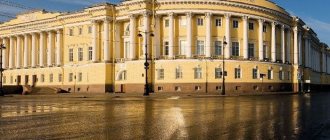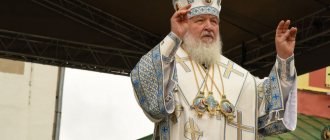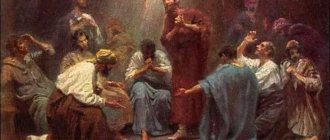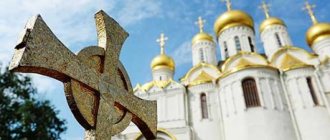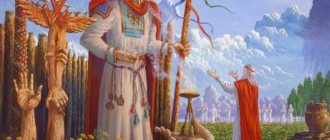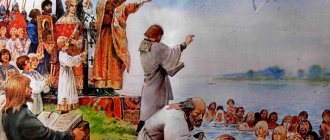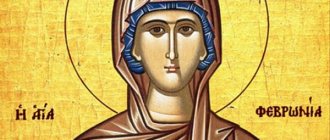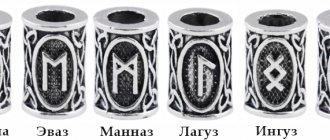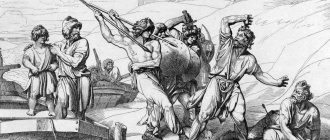Period X - beginning of the XII centuries. Adoption of Christianity in Rus'
At the end of the 10th and beginning of the 11th centuries. There is a restructuring of society on a territorial basis, the tribal community is replaced by a territorial one . This process is reflected in the history of the city community, which itself becomes territorial, and the Konchan-sotnaya system .
At the same time, the urban area was growing - city-states were growing and strengthening. In 980, Prince Vladimir united Kiev, Novgorod and Polotsk under his rule and became the sole ruler of Russia . Vladimir began to solve major state problems; he restored the unity of the Russian land. Strengthened the country's governance system.
One of the most important government reforms was the baptism of Russia in 988. It turned out to be associated with the internal political crisis in the Byzantine Empire.
The Byzantine emperors Constantine and Basil II asked Vladimir for help against the rebel Bardas Phocas. Vladimir promised to help the emperors, but on the condition that they give him their sister Anna as his wife. The emperors agreed, but demanded that the prince accept the Christian faith. After the defeat of Phocas, they were in no hurry to fulfill their promise. Then Vladimir captured the city of Chersonesos and threatened to capture Constantinople. The emperors had to agree not only to his sister’s marriage, but also to the fact that Vladimir was baptized not in Constantinople, but in Chersonesus. Returning back to Kyiv, Vladimir destroyed pagan idols and baptized the people of Yevan. The baptism of Vladimir and the people of Kiev marked the beginning of the spread of Christianity in Rus'.
The baptism of Rus' was explained by a number of historical reasons:
1) the developing state did not allow polytheism with its tribal gods and polytheistic religion. This undermined the foundations of the state. “One great prince, one almighty God”;
2) the adoption of Christianity contributed to the development of international relations, since in almost all European countries Christianity was accepted as a religion;
3) Christianity, with its idea that everything comes from God - both wealth and poverty, both happiness and unhappiness, gave people some reconciliation with reality.
The adoption of Christianity contributed to the flourishing of material culture (icon painting, frescoes, mosaics, construction of domes).
With Christianity came writing in the Slavic language. Schools arose at the monasteries.
After the adoption of Christianity, the East Slavic tribes united into the Old Russian people.
Pine Paradise
The youth of Moscow Rus' is resinous. She passed through pine paradise. One forest stood up after another if you climbed Borovitsky Hill and looked around at the opening distances. And this hill itself, as the name suggests, has been covered with forest since ancient times. Between the forests, strands of unhurried, flat rivers opened up, scattered across a remote swampy edge, like the hair of a beauty who had dozed off in a clearing. Water meadows and slopes framed their leisurely run. The smell of resin, pine needles, and flowering herbs floated over them.
The rivers are rich in fish, the forest is rich in animals, birds, and even the honey of wild bees. The soil is fertile. And the great troubles that broke the fate of ancient and great cities sometimes bypassed the Moscow wilderness. People returned time after time to the ashes, took up simple carpentry tools, built new mansions, new churches, new kremlins. Life won. Moscow land is a place where an invisible but strong source of life flows out from the deep depths. Here people are energetic, stubborn, quick-witted and courageous, here everything quickly multiplies, here the deepest wounds quickly heal.
Maybe this is where we should look for the reason for the amazing rise of Muscovite Rus'? Not on some great trade routes that supposedly went through the lands of Moscow - there were no merchant “highways” of ancient times here at all. And not in the forests, which supposedly protected the city from foreign invasions - they did not protect anything, neither from the attacks of their warlike Ryazan neighbors, nor from the Tatar raids. Simply: God loved the beautiful place, gave it wealth, and that’s why the inhabitants stuck to this place. And when the Tatar appeared with a lasso and a bow, more went to the golden cities on the beaten paths, less to their small relatives, the thicket dear to the Lord.
The destinies of Moscow, the local princely dynasty and Orthodox holiness, which early took root on Moscow lands, were intertwined in indissoluble unity. You take one - another opens, you look at another - and the pattern of a third appears.
The founder of the dynasty, peace lover and great diplomat Daniil Alexandrovich was already distinguished by great piety. Subsequently, he will be glorified among the saints. He got his hands on some beautiful land.
Daniil of Moscow created the territorial and political community that became Muscovite Russia. It was under him that the principality found its core - a necklace of cities surrounding Moscow, protecting it and awaiting its protection. It was he who, with his trust in God, his preference for a good peace over inter-princely squabbles, and his prudent economic management, set the fate of the entire region and the lifestyle of its rulers for a long time to come.
Archaeologists claim: it was under Daniil Alexandrovich that the first stone temple was erected in Moscow. It is known that the prince founded monastic monasteries on his land. Among the major strongholds of Russian monasticism, Daniil Alexandrovich is credited with founding the Moscow Epiphany monastery. But the greatest fame was acquired by another monument to his piety - the currently operating Moscow Danilov Monastery, the patriarchal residence (the main temple of the monastery was consecrated in the name of St. Daniel the Stylite). Here, the ancestor of the entire Moscow princely house became a monk before his death. Here, in accordance with Daniel’s will, he was buried - in the general monastery cemetery, “the cellar of the monastery and other brethren” (according to another version, he was buried in the Kremlin St. Michael the Archangel Church).
In 1920, the Chapel of Daniil of Moscow on Danilovsky Val was demolished, but 78 years later it was restored, and now it stands better than before - not far from the Tulskaya metro station. Near the chapel, at the intersection of Lyusinovskaya and Bolshaya Serpukhovskaya streets, there is a ten-meter high monument to Daniil Alexandrovich. In his left hand the prince holds a temple, in his right hand a sword. On his head is a royal crown with a cross. Nakhabino near Moscow was decorated with a church consecrated in the name of St. Daniel.
The role of the church in Ancient Rus'
Already by the end of the X-XI centuries. A harmonious system of organizing church religious life appeared in Rus'. It was created in the image and likeness of the Byzantine church, headed by the patriarch . The head of the Christian Church in Russia was the Metropolitan of Kiev and All Russia.
Schools and libraries appeared at churches and monasteries, the first of which were opened on the initiative of Prince Vladimir himself. The first Russian chroniclers, copyists and translators of famous church and secular works, and icon painters also worked here.
The church also contributed to the development of the country's economy. Prominent church figures, as well as monasteries already in the 11th-12th centuries. received land holdings from the grand dukes and developed their own economy on them.
A close relationship is established between secular and ecclesiastical authorities, with the primacy of the first over the second. In the first half of the 13th century. of ecclesiastical jurisdiction begins . Now the competence of the church includes the consideration of cases of marriage, divorce, family, and some inheritance matters. The Church also played a significant role in international affairs related to deepening relations with Christian states and churches.
The Church promoted humanity, tolerance, respect for parents and children, for the personality of a woman and mother, and called the people to this. The church also played a significant role in strengthening the unity of Rus'. Later, church leaders more than once played the role of peacemakers in princely feuds.
In large cities, ecclesiastical authority over Russian lands was exercised by bishops . In Novgorod, as one of the largest cities, the center of a large region, religious life was directed by the archbishop.
The Church opposed Roman-style Christianity. Those who proclaimed folk pagan culture were considered apostates.
Thus, the church contributed to the isolation of Rus' from Western European culture. For Rus', such a statement by the church was unacceptable, since Rus' collaborated with many Western European countries that preached the Catholic religion.
The Church flourished through the use of the labor of dependent people, robbed people through usury, etc. Many prominent church figures took part in political intrigues. Therefore, the actions of the church caused more negativity among people.
The adoption of Christianity in Kievan Rus contributed to its inclusion in the European Christian world, which means that Russia became an equal element of European civilized development. However, the adoption of Christianity in the Orthodox version had its negative consequences. Orthodoxy contributed to the isolation of Rus' from Western European civilization.
Time
What is Moscow Rus'? This is not the Muscovite state, understood as Russia before the moment when St. Petersburg became the capital.
This is not Vladimir Rus' - the north-eastern forest corner of the colossal power of the Rurikovichs, which unexpectedly for everyone left the background of big politics and received the significance of primacy under Andrei Bogolyubsky and Vsevolod the Big Nest. Moscow Rus' is both time and space at the same time.
Time - approximately from the end of the 13th to the middle of the 15th century. Just under two centuries. At the very beginning of this time, Moscow was nothing. Now it is a metropolis, one of the most famous cities in the world, the capital of a colossal country. But was it really predetermined that Moscow would take on the role of queen of Russian cities and lands? Why not Tver, not Novgorod the Great, not Vladimir, not Rostov, not Suzdal? All of them, with the possible exception of Tver, are far superior to Moscow in antiquity, they all became rich when there was no mention of Moscow, they all managed to try on the crown of the princely capital city long before Moscow had its own prince...
Miracles Monastery. Archive photo
For the first century and a half of its history, Moscow was in insignificance. Rich princely village. Then - a small stronghold set up by the Vladimir-Suzdal princes against Ryazan, like a weak card laid out on the table in a game with high stakes. Then Daniil of Moscow came to reign here, and from him the rise of Moscow began. But what kind of exaltation was this? Uncertain, uneven, for a long time walking on the verge of falling and death. Neither under Daniil of Moscow, nor under his children, nor under his grandchildren, would anyone vouch for the fact that Moscow would take precedence in Rus'. And even with his great-grandchildren, powerful neighbors disputed her primacy. Here the boy Dmitry ascends to the ancient princely table of Moscow, in the future - the famous Dmitry Donskoy. His government has to endure a fierce struggle for seniority and only with great difficulty, using military force, manages to wrest it from its rivals... And after the death of Dmitry Donskoy, the Moscow princely family will enter a period of internecine quarrels, which will subsequently result in a real civil war. All this time - from Daniil of Moscow to Ivan the Great - Moscow remains a contender for the role of an all-Russian center. Just a contender! But not a recognized lord and ruler.
Such is the turbulent time of Muscovite Rus'. But space... you can’t say it that easily.
Sergius of Radonezh. Big change
Moscow Rus' is consecrated in the name of St. Sergius of Radonezh. Outside of his spiritual exploits, outside of his spiritual authority, it is now impossible to imagine the historical destinies of the Moscow region, and indeed of all of Russia.
By the will of Metropolitan Alexy, many new monasteries were founded. Among them are the Moscow Region (now Moscow) Spaso-Andronikov Monastery, the Kremlin Chudov Monastery, and the Vladychny Serpukhov Monastery, which subsequently gained good fame. The Metropolitan of Moscow bequeathed to bury him in his beloved Chudov Monastery. But for that miraculous takeoff that the monasticism of Moscow Rus' experienced, most of all the energy was provided by the asceticism of St. Sergius of Radonezh. He is the alpha and omega of the amazing change that has occurred on Moscow soil.
Zaraysk Photo of the milestone. XIX–XX centuries
The life story of Sergius touches the Russian heart with a distant but clearly audible call: leave all self-interest, leave the city, go to wild and deserted places, to an island in the middle of a lake, to a thicket, to a cave, and there, in silence, think about God, cry out to him, then He will answer.
Saint Sergius was born into a family of Rostov boyars either in 1314 or 1322. Sergius retired from his hustle and bustle life. The elder brother Stephen and he took monastic vows and then settled in 1337 in a remote wooded area. On Makovets Hill they built a wooden temple in the name of the Holy Trinity. Unable to withstand the hardships of an unsettled life, moreover, cut off from city culture, Stefan left his brother and went to Moscow. There he settled in the Epiphany Monastery. And Sergius got a place where his silent concentration on dialogue with the Lord could not be interrupted by anything. News of a pious man who chose the dangerous and meager life of a hermit spread throughout the area. Around the wooden house of Sergius, a small community of disciples grew up - only 12 people, like the apostles of Christ. In 1354, Bishop Athanasius of Volyn installed Sergius as abbot. The abbot of the Holy Trinity Monastery on Makovets introduced a communal charter there, so unusual in Rus'.
Thus, from a small forest monastery, the great transformation of all Russian monasticism began. The spiritual authority of Sergius was unusually high. From time to time he leaves his small monastery and goes on long campaigns, exhorting the princes of the Russian land to abandon internecine wars. In addition to the community on Mount Makovets, Sergius gave birth to the Assumption Monastery near the village of Stromyn (about thirty kilometers from modern Noginsk) and the Annunciation Monastery on the Kirzhach River.
From here, from the Trinity Monastery, the disciples and spiritual companions of Sergius disperse throughout Northern Rus'. They become abbots of new monasteries - both in distant unknown lands and in the most beautiful tracts of Moscow Rus'. The list of ascetics who sowed Moscow Rus' with the seeds of great monastic work is extremely long.
Thus, the great luminary of Russian monasticism, the Monk Savva, founded the Savvino-Storozhevsky Monastery not far from Zvenigorod, which would later become the most famous throughout the Moscow region, in addition to the Lavra of Sergius himself.
The Monk Gregory headed the Kolomna Staro-Golutvina monastery. The Monk Methodius stands at the origins of the Nikolo-Peshnoshsky monastery, which arose not far from Rogachev.
The ancient land of Mozhaisk remembers the Venerable Ferapont of Belozersky with gratitude for the beautiful Luzhetsk monastery. The nephew of Saint Sergius, the Monk Theodore, founded the Simonov Monastery south of Moscow. Later it entered the city limits.
Sergius blessed Prince Vladimir Andreevich for the construction of the Vysotsky Conception Monastery in Serpukhov and gave him his student Afanasy, a great scribe, as abbot. With the blessing of the same Trinity abbot and the contribution of the brave governor, Prince Dmitry Bobrok-Volynets, the Mother of God Bobrenev monastery rose near Kolomna. As Church historian Georgy Petrovich Fedotov said, “The Trinity Lavra... became the center of spiritual radiation of enormous power.” Indeed, the paths of the monks, whom the Monk Sergius taught, are like rays of holiness, spreading everywhere from their sun, the Makovets community. Simultaneously with Sergius, a student of Kiev-Pechersk monasticism, the Monk Stefan, labored in the domains of the Moscow princes. This monk very strictly followed the monastic rules and was distinguished by his enormous knowledge. Near the present city of Alexandrov, 40 kilometers from the monastery of Sergius, he raised the Stefano-Makhrishchi monastery.
After the death of Saint Sergius, the heat of red-hot faith that filled his disciples, and through them many monastic communities of Moscow Rus', did not fade away. The spiritual leader of another great teacher of monks, the Monk Paphnutius of Borovsky, was a pupil of Sergius of Radonezh - Nikita of Serpukhov. By the will of Paphnutius, the Borovsky Nativity Monastery appeared - a new pearl, shining with grace.
